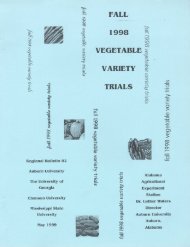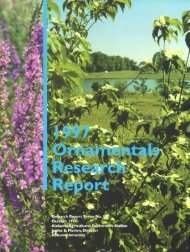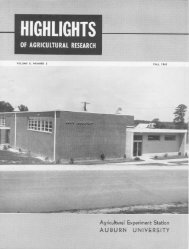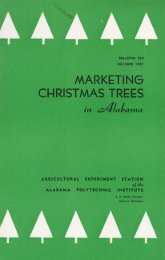Control of Sooty Blotch and Flyspeck - Auburn University Repository
Control of Sooty Blotch and Flyspeck - Auburn University Repository
Control of Sooty Blotch and Flyspeck - Auburn University Repository
Create successful ePaper yourself
Turn your PDF publications into a flip-book with our unique Google optimized e-Paper software.
During 1978, captafol (1976 rate) was applied in the green tip<br />
stage (April 3) <strong>and</strong>, subsequently, metiram (to five trees) was applied<br />
at 1976 rates on April 17 <strong>and</strong> 24, May 2, 9, 19, <strong>and</strong> 28, June<br />
9 <strong>and</strong> 23, July 7 <strong>and</strong> 21, <strong>and</strong> August 4 <strong>and</strong> 18. Dodine 5 (0.5 pound<br />
per 100 gallons water) was applied during bloom (April 10), followed<br />
by metiram cover sprays. Five trees were left unsprayed to<br />
serve as controls; however, fruit had rotted or dropped from two<br />
<strong>of</strong> these trees by harvest on August 29. One bushel <strong>of</strong> apples r<strong>and</strong>omly<br />
selected from each tree was evaluated for diseases.<br />
RESULTS<br />
Observations in 1974 indicated that the source <strong>of</strong> infection by<br />
the sooty blotch fungus might have been inoculum on twigs or<br />
leaves within the bags. <strong>Sooty</strong> blotch was most prominent in the<br />
stem depression <strong>of</strong> the fruit. Other sites <strong>of</strong> extensive infection<br />
were the blossom ends <strong>and</strong> areas adjacent to where leaves were in<br />
contact with the fruit. <strong>Sooty</strong> blotch developed where plastic bags<br />
were in contact with an apple, if the area was wet. Parts <strong>of</strong> apples<br />
submerged in condensate showed extensive sooty blotch.<br />
From the data,, it appeared that inoculum <strong>of</strong> Z. jamaicensis was<br />
not abundant on twigs at the time blossoms or apples were bagged,<br />
table 1. In addition to these data, 44 apples showing bitter rot,<br />
black rot, white rot, or other rots too extensive to permit evaluations<br />
for sooty blotch <strong>and</strong> flyspeck were also collected from the<br />
bags.<br />
Evaluations <strong>of</strong> sooty blotch <strong>and</strong> flyspeck development in 1975<br />
showed index ratings less than 2 on apples bagged during the<br />
TABLE 1. INCIDENCE OF SooTY BLOTCH AND FLYSPECK AT HARVEST ON APPLES<br />
ENCLOSED IN PLASTIC BAGS AT VARIOUS STAGES OF GROWTH DURING 19741<br />
Dates baggedApple Disease indices2 Apples<br />
Dates bagged growth <strong>Sooty</strong> blotch <strong>Flyspeck</strong> harvested<br />
April 9, 15, 23 Bloom 1.9 0.2 913<br />
April 30 3/ inch diameter 1.5 .7 40<br />
May 7 5/ inch diameter 1.9 .7 29<br />
August 15<br />
(control) not bagged 4.7 2.9 38<br />
i1Data are averages from apples harvested from six trees on August 15.<br />
2Disease severity scale: 0 - no disease, I -= trace, 2 = 2-10 percent, 3 = 11-25<br />
percent, 4 = 26-50 percent, 5 = 51-100 percent <strong>of</strong> fruit surface diseased.<br />
3Number <strong>of</strong> apples harvested per treatment; rotted apples were not included in<br />
totals.<br />
5Cyprex 65WP.<br />
[6]
















